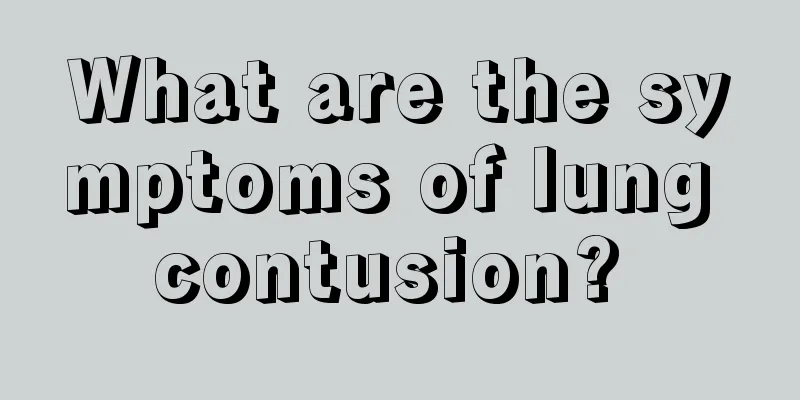What are the symptoms of lung contusion?

|
Pulmonary contusion is a common lung disease, but many friends are not aware of this disease. There are many causes of lung contusion, such as compression or impact caused by external force. The more obvious symptoms of pulmonary contusion are chest pain, chest tightness, and shortness of breath. These feelings are also very obvious to patients, so they can be discovered in time. Pulmonary contusion is a common injury to the lung parenchyma, mostly caused by rapid blunt trauma, such as traffic accidents, collisions, crushing and falls. The incidence rate accounts for about 30% to 75% of blunt chest injuries, but it is often ignored or missed due to insufficient understanding, insensitive examination techniques or being masked by other chest injuries. Disease Overview Pulmonary contusions mostly occur in patients with blunt trauma, often accompanied by severe bony thorax injuries, such as flail chest; they may also be caused by high-pressure air waves or water waves generated by the explosion impacting the chest wall and colliding with lung tissue, which is called pulmonary blast injury. Pulmonary contusion can cause damage to lung cells and blood vessels, and bleeding into the lung parenchyma. More importantly, the inflammatory response after contusion promotes the deposition of inflammatory cells and the release of inflammatory mediators, increases the permeability of pulmonary capillaries, and causes the intravascular fluid to seep into the extravascular space, accumulate in the alveoli and pulmonary interstitium, causing ventilation-perfusion imbalance and hypoxemia. Clinical manifestations Due to the different severity and extent of pulmonary contusion, the clinical manifestations vary greatly. In mild cases, there are only chest pain, chest tightness, shortness of breath, cough and bloody sputum, and scattered rales are heard on auscultation. There are patchy shadows on the chest X-ray (often reported as traumatic wet lung), which can be completely absorbed in 1 to 2 days. Blood gas may be normal. Some people call it pulmonary concussion. In severe cases, there are obvious breathing difficulties, cyanosis, bloody foamy sputum, tachycardia and hypotension. Auscultation reveals widespread rales, decreased to absent breath sounds, or tubular breath sounds. Arterial blood gas analysis is of reference value before hypoxemia is revealed on chest X-ray. Chest X-ray is an important means of diagnosing pulmonary contusion. In about 70% of cases, the changes appear within 1 hour after injury, and in 30% of cases, they may be delayed to 4 to 6 hours after injury. The range may be from a small localized area to one or both sides, and the degree may range from spotty infiltration, diffuse or local spotty fusion infiltration, to diffuse large infiltration or consolidation shadows in one or both lungs. After treatment, it usually starts to be absorbed 2 to 3 days after the injury, and it takes more than 2 to 3 weeks for complete absorption. In recent years, through serial CT examinations, new pathological viewpoints on pulmonary contusion have been proposed. The contusion shown on X-ray films appears on CT films as a laceration of the lung parenchyma and an alveolar hemorrhage surrounding the laceration without any pulmonary interstitial damage. Disease treatment Minor pulmonary contusions should also be treated. Severe pulmonary contusion is the most common factor causing acute respiratory failure after chest trauma. Treatment is to maintain respiratory and circulatory functions and appropriately deal with associated injuries. Flail chest often has varying degrees of pulmonary contusion. The pathophysiological changes depend to a large extent on the pulmonary contusion. When the signs of acute respiratory failure appear, mechanical ventilation should be given in a timely manner. At present, the use of corticosteroids is no longer emphasized as in the past. For those with hypovolemic shock, blood volume should still be replenished in time, the ratio of crystalloid and colloid fluids should be reasonably matched, normal colloid osmotic pressure and total osmotic pressure should be maintained, and negative fluid balance should be maintained thereafter, with a daily volume of 1600 to 1800 ml. |
<<: What are the symptoms of burn wound infection?
>>: What to eat after egg retrieval to restore ovaries
Recommend
Will eating mangoes cause spots? Nutritional value and precautions of mango
It is good to eat mangoes, because mangoes are kn...
Allogeneic hair transplant?
To put it simply, allogeneic hair transplantation...
How long does it take to become a muscular man
It takes a certain amount of time for us to exerc...
Shock! A single move can cause 10 diseases in the whole body
With the increase of social competition and work ...
Blurred vision is a sign of liver abnormality
In Chinese medicine theory, the liver opens up to...
How does honey shrink pores
Nowadays, people are paying more and more attenti...
How many days after fertilization does implantation usually occur
Many women who want children, when they are prepa...
Contact lens eye drops
With the continuous development of modernization,...
What are the methods to remove dandruff
Many people want to have healthy hair, especially...
What to do if you have an allergic reaction to eye patches
In modern urban life, the fast pace of life, high...
What are the early signs of colon cancer?
Intestinal cancer is mostly adenocarcinoma and sq...
We'd better pay attention to the causes of colorectal cancer
Nowadays, the incidence of colorectal cancer is i...
Who are the high-risk groups for liver cancer? These 4 types of people are the high-risk groups for liver cancer
Liver cancer is a common disease in my country, a...
What foods can prevent brain cancer
It is said that prevention is better than cure. I...
What to do if the stool is yellow and has no shape
Yellow and unformed stools are quite common. Many...









